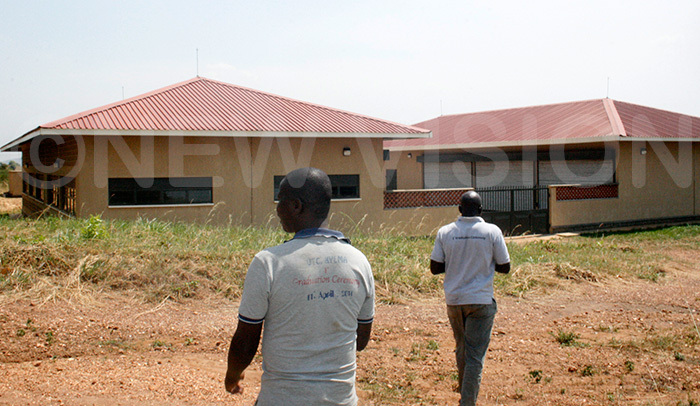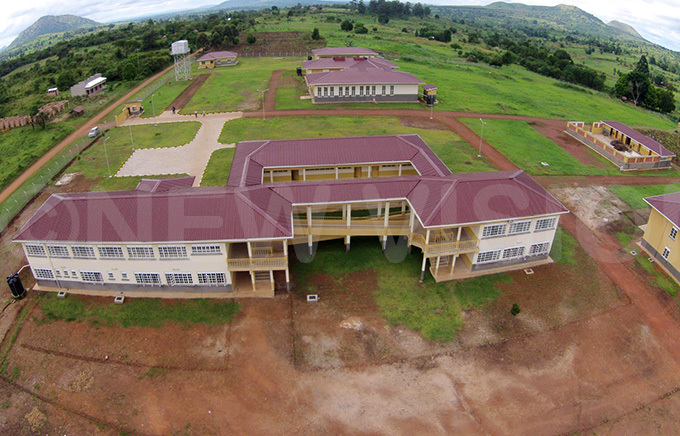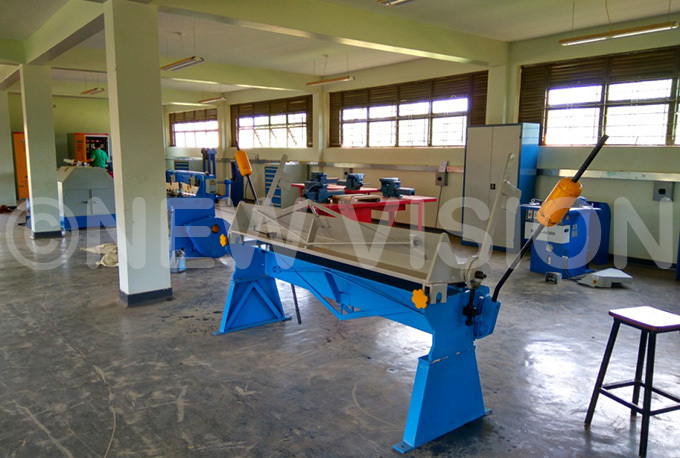Govt borrows over sh2 trillion for skills, but fails to get students
Most institutions the Government has constructed and equipped to churn out technicians are stuck with magnificent buildings but few students.
The Government has borrowed over sh2 trillion to build and equip vocational and technical institutes over the last eight years under the Business Technical and Vocational Education and Training (BTVET) sub-sector, Saturday Vision has learnt.
However, Uganda could fail in its bid to supply technicians for the oil industry by 2020 when the country is expected to start extracting the resource. A total of 60% of the workers during the development phase of the oil industry will be technicians.
Most institutions the Government has constructed and equipped to churn out technicians are stuck with magnificent buildings but few students. The development raises questions about the country's needs assessment conclusions for the sector — and the ability to plan for the borrowed resources and ensure value for money.
Over the years, Uganda has secured loans for BTVET from the African Development Bank (AfDB), World Bank, Organisation of Petroleum Exporting Countries (OPEC) and from Koreans. Others include International Development Bank, Islamic Development Bank (IDB), Saudi Fund for Development and Kuwait Fund for Arab Economic Development.
Besides using the cash for raising manpower for the oil industry, the Government also intended to use it to produce more technicians in a bid to bridge the skills gap in industrial sector, billed as the answer to Uganda's acute unemployment problem, now standing at 58% of the 18 million Ugandans in the working age bracket.
The initial loan tranche ($400m) was spent on rebuilding, equipping and expanding institutions such as Rukungiri, Jinja, Madera, Kabasanda, Dokolo, Iganga, Mubende, Kiryandongo, Arua and Kanungu technical institutes.
An estimated 700,000 graduates enter the labour market each year, and this is projected to increase to over 1.5 million by 2040, according records from the finance ministry. Only about 90,000, however, are getting absorbed into the job market. The reason given was that the graduates do not possess the required skills. The skilling Uganda programme was, therefore, designed as a magic bullet to this acute unemployment.
"The demand for bricklayers, welders, electricians and plumbers will surge, which is why we are investing heavily in technical and vocational skills," Keith Muhakanizi, the permanent secretary of finance ministry, said in 2014, to justify the heavy investment in the skilling Uganda programme.
 Students at UTI, Kyema in Masindi district
Students at UTI, Kyema in Masindi district
The loans
But an investigation by Saturday Vision reveals that the returns from the investment are a mockery of the resources invested.
For example, in the 10-year skilling Uganda strategic plan (2011-2020), the Government planned to raise the number of graduates to 450,000 annually, with 50% female population. However, only fewer than 200,000 personnel have been produced, two years to the oil production commencement in 2020. Even for those so far produced, questions are being raised about their competence.
According to the Gulf Interstate Engineering, a company that undertook the Front End Engineering Design (FEED) study in December last year for the 1,445km East African Crude Oil Pipeline (EACOP) between Uganda and Tanzania, technicians and craftsmen/women are needed to build, among others, construction and pipe yard marshalling camps, welding pipes, civil works for pump stations and mechanical/electrical instrumentation construction.
"The opportunities are coming. You need to get prepared," Mark Lamb, the GIE engineer on the EACOP project, said.
The construction of an oil and gas industrial park at Kabaale in Hoima, including the 600,000 barrels per day refinery, an international airport, an export hub and other facilities will require substantial numbers of technicians.
"But there is still a huge gap when you look at the manpower and capacity needs. And there are now timelines for the development of the industry. We should be scaling up training now and improving the competence levels of the people," Denis Kamurasi, the vice-chairperson of the Association of Uganda Oil and Gas Service Providers, said.
In that light, Uganda could resort to hiring consulting technicians who are more expensive, compared to nationals.
 Julius Kapwepwe the director of programmes at Uganda Debt Network
Julius Kapwepwe the director of programmes at Uganda Debt Network
What's going wrong?
With approximately $400m war chest (of the over $550m earmarked for the 10-year BTVET project), the Government set about revitalising the BTVET sector by, among others, constructing and equipping new technical institutes, as well as rehabilitating old ones.
In total, 25 of the 123 technical institutes benefited from the funding, either by getting modern buildings or equipment.
Kilak Corner in Pader district was one of them. Constructed at the cost of sh5.7b using a loan from AfDB and OPEC, the institute's complex, comprising four brown-roofed-storeyed buildings, with air-conditioning and a marvelous furnishing, is magnificent.
It also includes the administration blocks, library/ICT centre, single-level workshop blocks, dormitories and classroom blocks with sitting capacity of 120 students, staff housing units and separate accommodation structures for the principal, as well as a kitchen block.
Setting up the institute was also informed by the huge number of unschooled and jobless youth affected by the decades of the Lord's Resistance Army insurgency.
However, the beauty of Kilak Corner fades when you get up-close. A thick bush has swallowed some of the blocks, with many of the classrooms not in use. So far, the institute has six instructors on the Government payroll, of the required 16. In May last year, however, in a bid to bridge the staff gap, the Government posted 10 more instructors there. However, they say, they have not received salaries for the last seven months.
"Most are saying they are not coming back next term," the principal, Gregory Kasapuli, said.
Courses offered at the institute include motor vehicle mechanics, carpentry and joinery, but the core subjects were expected to be welding and fabrication.
Metal fabricators play a crucial role in the oil industry, producing pipelines, hollow sections, platforms, beams, girders, custom-fitted metal elements, pressure vessels and heat exchangers. But the institute is yet to produce any such personnel despite the sh5.7b outlay.
When asked why, Kasapuli put the blame on staff grumbling over unpaid wages.
Since the institute opened in 2015, it has drifted from one financial crisis another, a situation that has affected enrolment. By December, last year, the institute had only 80 students out of the 350 that it is supposed to have.
It is believed Kilak is not the only institute struggling. Lyantonde Technical Institute cost sh9b — a loan funding from Saudi Fund for Development in 2016. President Yoweri Museveni commissioned the institute. But two years later, it has failed to pick up. Currently, only three courses are offered, including a certificate in building, construction, plumbing, welding and metal fabrication. The institute was supposed to offer seven courses.
"Some of us see magnificent buildings, but we do not know what takes place there," Jacob Byaruhanga, a resident, told Saturday Vision.
Then, there is Abia Technical in Alebtong, which cost a similar figure, but had, by closure of the semester in December last year, an enrolment of only 35 students.
 Buhimba Technical Institute in Hoima
Buhimba Technical Institute in Hoima
Has the original plan backfired?
According to the World Bank, BTVET is crucial in fighting youth unemployment, relieving demographic pressure on higher education institutions by diverting student aspirations and serving academically less able students. But BTVET is expensive to run — the reason the Government embarked on massive borrowing to finance it.
However, even with huge inflows of dollars from lenders, most heads of BTVET institutions say only a fraction of funds they need to operate is remitted by the Government. For example, while most institutes need between sh100m and sh120m in capitation grants to operate for a year, most, on average, are getting between sh40m and sh60m.
According to a report released in 2014 by the Economic Development Policy and Research Department of the finance ministry, annual training costs in public BTVET institutions stand at between sh1.5m and sh3.5m per student.
The report, Uganda's Employment Challenge: An Evaluation of Government's Strategy, said at least 45% of the training costs are currently borne by the private students, which should be a relief for the Government to substantially cover the remaining costs.
But then there's a problem. Many institutes are struggling to attract private students — their cash cow — for various reasons. For example, all the 35 students enrolled at Amelo Technical Institute by the end of term last December were under the Government sponsorship. Asked why, Ben Kamba, the institute's principal said: "The community cannot afford."
He added that even for the 35 students the institute currently has, they were just hunted for from the community. As if that is not bad enough, even with the few government-sponsored students they received, they failed to pay the sh50,000 functional fees. The situation makes it difficult to run some programmes.
By the close of last term in December, there were 120 students at Lwengo Technical Institute, only 20 of whom were under private sponsorship. While at Kilak Corner Institute, of the 80 students that the school has, only three are private students. This implies that even the strategy of enrolling private students is not efficient to close the funding gap.
Incompetent graduates
According to Patrick Mbonye, the managing director of Q-Sourcing, a company training and accrediting technicians for oil and gas industry in Uganda, the country is struggling to raise the skills it so desperately needs to grow its economy. In the oil industry, for example, only 200 oil welders have been accredited out of thousands that the country needs.
The report by the finance ministry summarises the problem. "The BTVET sub-sector faces challenges, including significant technological lags, with many institutions using outdated equipment, which are not relevant for today's market; staffing gaps; negative attitudes among staff and students; rigid courses with inadequate emphasis on practical training; and poor monitoring of service providers," the report said.
It, however, noted that there had been noticeable improvement with increased funding for training materials and infrastructure, introduction of the new BTVET curriculum and the emergence of new bodies, such as the Uganda Business and Technical Examinations Board (UBTEB) and the Uganda Allied Health Examinations Board (UAHEB), which provide specialised and standardised assessments.
But it added, damningly, that progress has been slow. Some institutions still have limited equipment for practical work, with most having fewer than 60% of staffing positions filled.
It also revealed that few graduates from formal BTVET institutions are able to create jobs for themselves or others due to insufficient emphasis on business and entrepreneurial skills.
"Although the Government has prioritised vocational training to create ‘job makers' rather than ‘job seekers', job creation among formal BTVET graduates has been far less than expected. For example, only one of the 24 graduates from the Elgon Technical College interviewed were self-employed," the report added.
Compounding debt situation
Julius Kapwepwe, the director of programmes at Uganda Debt Network, says the failure to make the best use of borrowed resources for BTVET means Uganda could find itself saddled with an unnecessary debt, complicating its already bad public debt situation.
"Public debt is already in excess of $14b (sh50.9 trillion) inclusive of disbursed and undisbursed loans, contingency liabilities, domestic arrears, land compensations and debt due to recoverable costs from private sector investment in oil and other high capital risk sectors," he said. He added that this translates into a debt of approximately sh1m per Ugandan. This is untenable and in a bid to service the mounting debt, the Government could be forced into hiking taxes to meet debt repayment obligation, affecting the quality of life of Ugandans.
Way forward
Before the Government undertakes to borrow, a thorough feasibility study and planning should be done to forestall resource wastage.
"It is imperative that both the donors and the Government periodically publicise what they fund, in order to account to Ugandans who are staked for such huge borrowing to gauge the level of performance and success rate for each loan," Kapwepwe said.
What the ministry says
The BTVET commissioner, Safina Musenne, said the loans secured to fund skilling Uganda were secured in good faith and that what needs to be done is to sensitising Ugandans about the value of technical education.
"Enrollment is low because of attitude. Senior Four exams were released in January and every student wants to join A-Level. After completing A-Level, everyone wants to join a University regardless of its name," she said.
Auditor General's report
According to the Auditor General Value for Audit report (2015), standards have not changed despite the sector having its budget dramatically increased.
The report revealed that while BTVET's strategic plan aimed at increasing access to vocational and technical education through increased enrollment and retention of the current student population, enrollment was actually dropping in many of the institutes.
"Analysis of 11 institutions showed that the general drop-out rate reduced from 25.7% in 2012/13 to 19.7% in 2013/14. However, several institutions, for example: Iganga, Rukungiri, Kitovu, Nakapiripirit and St. Joseph's Kisubi technical institutes continued to post dropout rates above 20%. Iganga had the highest dropout rates of 63.7% and 54.5% in 2012/13 and 2013/14, respectively," the report revealed.
The report also found out that despite the Government procuring expensive equipment for the institute, much of it was not in use. For example, at Katonga Technical Institute, the AG found the jai wood planner, hand drill, overlocking machine, an electrical design machine and gas welding system had never been used, despite the government spending millions to purchase them.
As a result, the AG, John Muwanga, said skills such as welding, comprehensive design and trimming boards were not taught. Meanwhile, at Nalwire Technical Institute, the three-phase welding machine as well as the sheet bender and spray gun for advance welding, plumbing and painting decoration, respectively, were lying idle, reportedly because the institute could not afford electricity to run the machines.
This, the AG said, contravened basic requirements and minimum standards provided by the Directorate of Education Standards requiring technical institutes to undertake 60% practical training, which translates into 18 hours per week on practical work and 12 hours on theory.
Thus, many students were leaving institutes without attaining the recommended practical content and experience at BTVET institutions.
"This, coupled with the failure by MOESTS and institutions to recruit and post instructors with industrial experience, may render the intentions of the BTVET sub-sector to provide relevant skills required to the world of work hard to achieve," the report stated.
 New mechanical engineering machines in a workshop at UTC in Lira district
New mechanical engineering machines in a workshop at UTC in Lira district
A graduate's testimony
Kennedy Kisekka graduated as a welder from Nakawa Vocational Institute, a BTVET institution, a few years ago. After reading in the media that welders would be in high demand for the oil industry, he chest-thumped at his wisdom to choose welding over some other course that his parents had preferred for him at college.
To his disappointment, however, Kisekka learnt that even with a welding certificate, he must first undergo a test to be accredited for the lucrative oil industry at St Simon Vocational Institute in Hoima.
Kisekka undertook the test, together with 23 other welders who had graduated from different vocational institutes.
"We were asked to weld two pieces of metal plates to gauge our level of understanding of the trade," he said. The plates each group had welded were subjected to a bend-test to establish if they had been melted properly, before welding them and if they would bend without breaking.
All of them failed the test. "We thought we were already accomplished welders!" he said.
Their work had several welding defects and gave the tutors an idea of their level of competence based on the nature of the training they had received.
"At most institutes, you are taught how to hold a welding rod, but there is more than just that. In Hoima, we were given tools and we did not know what to do with them," Kisekka said.